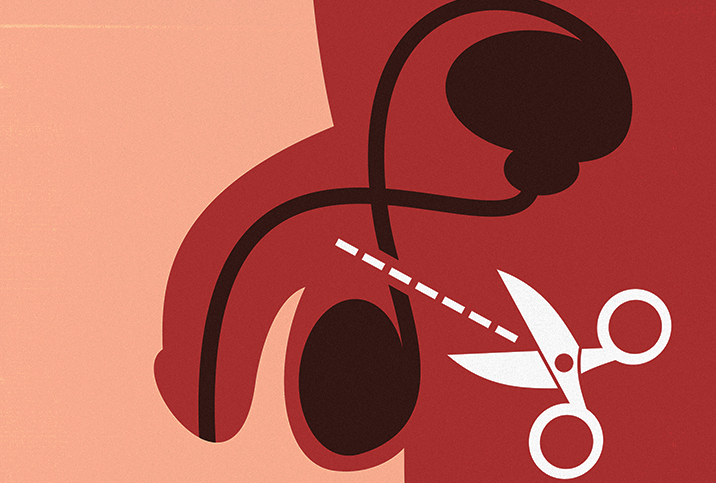We Have Questions: Vasectomies

If you're a man in the market for a permanent method of birth control, then the vasectomy route is probably going to be heavily recommended by your doctor. Not only are the procedures relatively inexpensive, they are also safe and effective—only about 1 in 2,000 fails.
"Success rates are greater than 99 percent, so less than 1 percent fail," said Scott Lundy, M.D., Ph.D., an infertility fellow at the Cleveland Clinic Foundation.
A vasectomy, which entails a straightforward, minimally invasive series of steps, usually takes about 15 minutes or less and is commonly carried out in a doctor's office.
Despite the simplicity of the procedure, there is a lot to know. In this Q&A, Lundy explains the ins and outs of a vasectomy, including its risks and benefits, and what kind of follow-up testing is required.
What exactly is a vasectomy?
Essentially, it's the blocking or cutting of the vas deferens, which is the tube that carries sperm from the testicles to the urethra.
We make a small incision on either side of the scrotum, find the vas deferens and pull it out of the incision. It's a magical moment, like if you were to pull a rabbit from a hat. Next, we strip down the tissue around the vas deferens to prevent serious bleeding and then clip it with either metal clips, tie it, or cut it and cauterize it, or a combination of those things. Some doctors put a piece of tissue between the two ends of the clipped vas deferens so there can't be a new formation between the two ends.
When a couple decides to not have children, a vasectomy is a very safe procedure as compared to asking the female to undergo a procedure for sterility, because it does not require anesthesia or an operation in the abdomen. As bad as it sounds to have an incision in their scrotum, the pain is manageable and men tend to do well with it. Most of the procedures take about five minutes in my experience.
What are the most common reasons for men to want a vasectomy, and what kind of information do they need to know before making the final decision?
Men who desire to not have any more biological children often come to us for an evaluation for a potential vasectomy. However, it does not take sexually transmitted diseases (STDs) off the table or change the risk of contracting one. It also doesn't change orgasms or the ejaculate, and it's important for them to know this upfront.
From there, we'll tell them about the procedure and risks, and it's our job as urologists to guide them through this process and help them understand this is designed to be a permanent solution for fertility.
What are some common risk factors?
The main thing patients need to know is it's a procedure that can be performed in the clinic or performed under anesthesia, but we try to avoid trips to the operating room when possible.
Failures are rare. When do they normally occur?
Failures can occur early or late. Early means the procedure was done and a structure other than the vas deferens was divided. This does happen occasionally and is part of the reason we ask every patient to be evaluated afterward. A late failure can happen months or years later if the two ends rejoin, but it's very rare.
What are the primary methods of performing vasectomies today?
Overall, there are lots of buzzwords for techniques, but the most common is a no-scalpel procedure. Many people use a sharp tool to poke through the skin, and it is fairly painless and heals well.
So it's fair to say the no-scalpel technique is the most common?
I would say yes, at this point, it's certainly the most discussed, but there's not a big difference in the long term between techniques.
Is there a least common technique?
We typically try to avoid the operation room, because then there are risks with anesthesia and added healthcare costs for that. The times we would consider that is if they're unable to tolerate pain or have a hard time with it, or if we feel we cannot adequately feel the vas deferens, which makes it harder to pull out and cut safely.
Are there possible side effects?
In terms of complications or side effects, almost all men will have some bruising and swelling, and feel like they got kicked for a day or two. Some men will have significant bruising or swelling. Others can develop swelling in the testicle and an infection called epididymitis, which may require antibiotics.
Finally, there could be a pain in the testicle where there's fluid buildup, like a blocked pipe. Sometimes we treat that with over-the-counter meds, and if it doesn't [respond], we can strip the nerves going to the testicles in surgery or reverse the vasectomy with the understanding that they'd become fertile again.
Many men have blood in their ejaculate after the procedure, and that's normal, probably in the first few weeks to a month.
What's the recovery period and what kinds of limitations does a vasectomy put on men, physically speaking?
From the moment of surgery, everyone is sore for the first few days. We suggest using frozen peas or ice on the scrotum to help with swelling or pain, and over-the-counter pain meds like Tylenol. Most men wear supportive underwear. Another aid is the use of a towel at bedtime to raise the scrotum.
The first few days, they're probably sitting around not doing a whole lot, and most men can go back to work one to three days after the procedure.
We ask that they avoid heavy lifting for a week after surgery, which would be anything more than 20 pounds, because it could open an incision or cause bleeding. We also ask them to wait a week for sex, for healing. Most men recover quickly after that. The ones with more swelling may take an extra week, but they eventually recover like everyone else.
What testing and follow-up care are done to make sure a vasectomy was successful? What is the protocol immediately following the procedure, after a few weeks and long term?
We usually get a post-vasectomy semen analysis (PVSA) three to four months after the procedure, which usually requires a combination of time and several ejaculations to clear what's left in the vas deferens in terms of leftover motile sperm. We can do it earlier, but if we test too early and it's positive, we'd have to test again.
Residual sperm in the ejaculate certainly happens, and we reassure the patient that they haven't necessarily reached failure at that point. It's also important for them to know they can absolutely cause a pregnancy at this point. Many men don't come back for the first test, let alone follow-up tests, and they could cause pregnancy because we haven't been able to tell if the procedure is successful.
How does the analysis test work?
We compare the number of motile sperm versus the number of nonmotile sperm, and there are technical limits to what can be present.
If the vasectomy fails, what is the protocol from there?
Essentially, we repeat the procedure and maybe add additional ties, clips or blockages, along with ensuring we're cutting the correct structure. Typically, we'll repeat the procedure and we'll sometimes take the segment of vas deferens out and send it to the pathologist to confirm it's indeed the correct structure.
What's the timeline for another procedure?
We can proceed at any point following the testing. There's no reason to wait any further.
You said many men skip the first test. How common is that and why?
At the Cleveland Clinic, we published a paper that indicated 25 percent of men did not follow up. If I could choose to highlight a point of emphasis, that would be it, particularly for patients with spouses. This is far, far too common—the number is very striking to me. Men go through a procedure and expect an outcome and then don't come back to check to see if it was successful. We, as urologists, want good outcomes for our patients, and when accidental pregnancies happen, it's hard for everyone.
I think part of the challenge is asking men to give a semen specimen in a lab, which could be intimidating because you're asking them to do something personal in an impersonal place. Maybe people don't want to see a physician, which could be part of it. Finally, because the success rate is so high, people may assume it's successful. I can tell you that the urologists who do this procedure emphasize the follow-up tests to patients. We put it in big bold letters that this testing is mandatory.
You mentioned late failures, so is there any testing down the line, even for the initial successes? Do you follow up at a year, five years, etc.?
It is very rare. We don't offer testing or evaluation in the long term, but we'd be happy to if a patient approached us. There are home semen analysis tests some men will use, but those all vary as to how results are reported and maybe a little different from how we analyze data.


















